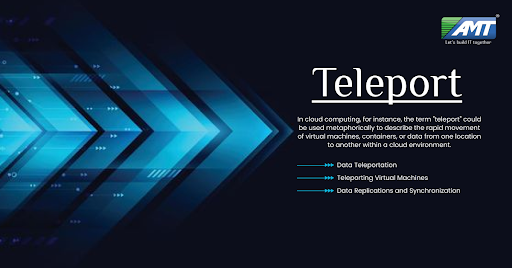“Teleport” in the context of IT generally refers to a concept in networking or data transfer, rather than the literal sci-fi teleportation of objects or people. It’s a term used to describe fast and efficient data movement between locations, often in the context of distributed computing or cloud infrastructure.
In cloud computing, for instance, the term “teleport” could be used metaphorically to describe the rapid movement of virtual machines, containers, or data from one location to another within a cloud environment. This could involve moving workloads from on-premises servers to cloud servers, or even shifting data and applications between different cloud providers.
Remember, the term “teleport” in IT is not about physically moving objects but rather about the efficient transfer of data, applications, or computing resources across digital environments. The actual implementation of teleportation-like concepts from science fiction remains firmly in the realm of fiction due to the current limitations of our understanding of physics.
- Data Teleportation: In IT, “teleportation” can metaphorically refer to the high-speed movement of data across networks or between storage systems. Technologies like Content Delivery Networks (CDNs) work to teleport data closer to end-users by caching content on edge servers, reducing latency and improving user experience.
- Teleporting Virtual Machines: In the context of virtualization and cloud computing, “teleporting” a virtual machine refers to migrating it from one physical host to another without disrupting its operation. Live migration allows VMs to move seamlessly between servers, ensuring uptime and resource optimization.
- Data Replication and Synchronization: Teleportation can be associated with replication and synchronization of data across distributed systems. Data teleportation ensures that data is kept consistent across multiple locations, reducing the risk of data loss and improving disaster recovery capabilities.
- Edge Computing and IoT: With the rise of edge computing and the Internet of Things (IoT), data teleportation can involve rapidly transmitting and processing data from edge devices to centralized cloud systems for analysis, allowing real-time decision-making and responsiveness.
- Blockchain and Smart Contracts: In the context of blockchain, “smart contracts” can be seen as a form of digital teleportation. These self-executing contracts automatically trigger actions or transactions when certain conditions are met, allowing for decentralized and automated processes.
- Decentralized Systems: Teleportation might relate to decentralized file storage systems, where data is broken into smaller pieces and distributed across a network of nodes. When a user retrieves the data, it’s reassembled and “teleported” back to them.
- Data Migration and Portability: The concept of “teleporting” can also extend to data migration and portability between different platforms or environments. For instance, moving data and applications from on-premises servers to cloud infrastructure or between different cloud providers.
- Teleportation in Gaming: In the context of online gaming, teleportation can refer to the instant movement of a player’s character or avatar from one location to another within a virtual world. This is commonly used to quickly navigate large game maps.
Remember, in IT, “teleport” is often a metaphorical term that captures the essence of quick, efficient, and seamless data movement, rather than literal teleportation of physical objects. The various applications mentioned above highlight how this concept is used across different domains within the field of information technology.
Above is the brief about Teleport. Watch this space for more updates on the latest trends in Technology.
